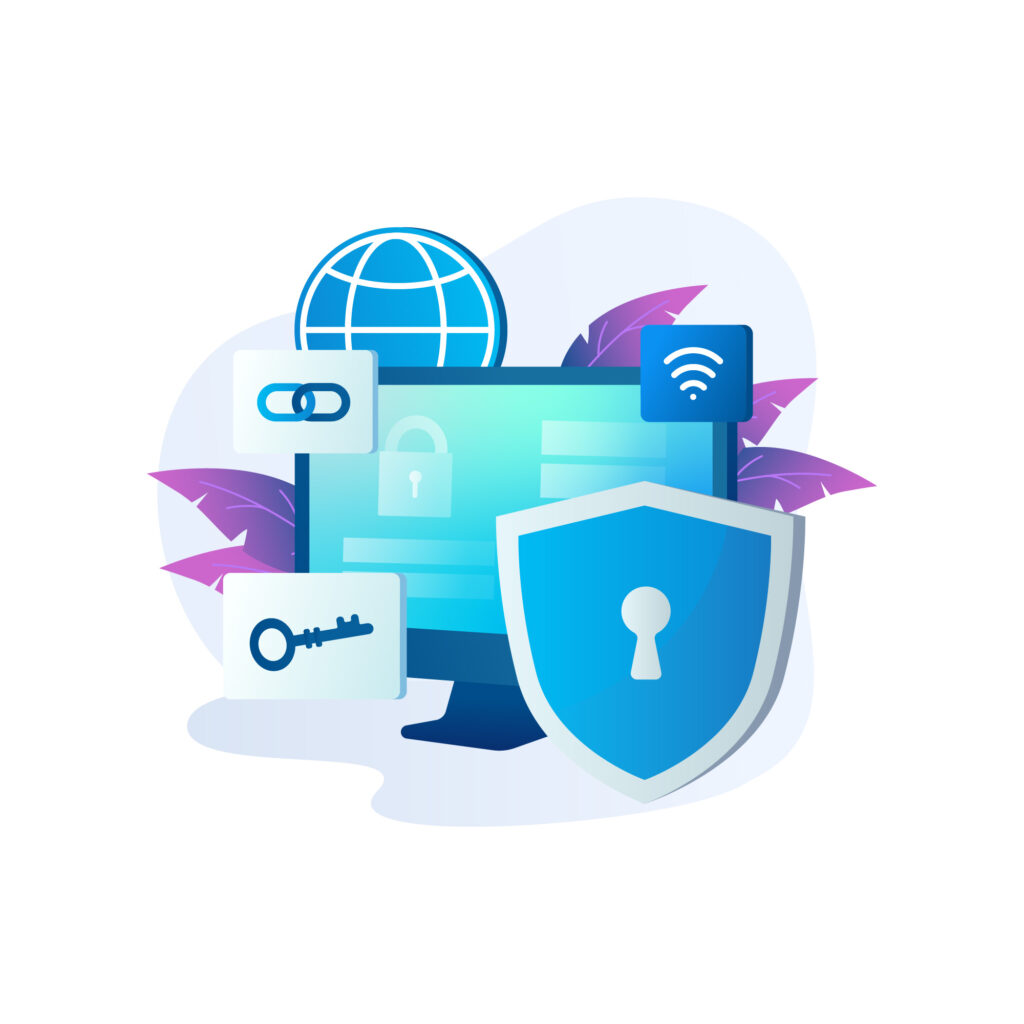Future Trends in Network Security And Advantages
It is crucial to stay updated with the future trends in Network Security. Network security is constantly evolving, and so are the threats.
The Rise of Artificial Intelligence (AI) and Machine Learning (ML):
Artificial Intelligence (AI) and Machine Learning (ML) are on the brink of revolutionizing network security practices. These technologies allow security analysts to get maximum details of network traffic data in real time.
By leveraging sophisticated algorithms, AI and ML algorithms can swiftly identify anomalies and potential threats lurking within the network infrastructure.

Furthermore, the integration of AI and ML enables the automation of incident response mechanisms, streamlining the entire security process. This automation not only accelerates threat detection but also facilitates rapid and effective responses to emergent security incidents.
In essence, the synergy between AI, ML, and network security heralds a new era where security teams can proactively safeguard digital assets with heightened agility and efficacy.
Embracing the Zero Trust Security Model:
In traditional network security, reliance on perimeter defenses like firewalls has been the norm. However, it is swiftly evolving with the proliferation of cloud computing, the ubiquitous presence of mobile devices, and the widespread adoption of remote work practices. Consequently, the once-impermeable boundaries safeguarding networks are now porous and vulnerable to sophisticated cyber threats.

The Zero Trust security model represents a radical departure from this traditional approach. Rather than presuming trust based on location or network boundaries, it operates on the foundational principle that no entity—whether user or device—should be inherently trusted. Instead, each access request is subject to rigorous and continuous verification, regardless of its source or context.
This paradigm shift is particularly crucial in today’s dynamic and distributed network environments. With traditional perimeters fading into obsolescence, the Zero Trust model offers a proactive defense mechanism against evolving cyber threats. By adopting a granular and context-aware approach to access control, organizations can effectively mitigate risks associated with unauthorized access, data breaches, and insider threats.
The Zero Trust security model represents a fundamental reimagining of cybersecurity practices, aligning with the realities of modern digital ecosystems. By prioritizing continuous authentication and authorization, organizations can fortify their defenses and safeguard sensitive assets amidst the ever-changing threat landscape.
Securing the Internet of Things (IoT) Landscape:
As the number of interconnected devices, collectively known as the Internet of Things (IoT), continues to surge, so does the concern over their susceptibility to cyber threats. Many of these IoT devices are deployed with insufficient security measures in place. This will make them vulnerable targets for malicious actors seeking to exploit weaknesses in their defenses.
This exponential growth in IoT adoption has significantly expanded the attack surface available to cybercriminals. This will amplify the urgency for robust security solutions. Addressing this critical need requires a proactive approach that not only acknowledges the magnitude of the threat but also recognizes the unique challenges inherent in securing IoT ecosystems.

One of the primary obstacles in securing IoT devices lies in their inherent limitations, such as constrained processing power and memory resources. Unlike traditional computing devices, many IoT endpoints are designed with minimal computing capabilities to optimize energy efficiency and cost-effectiveness. Consequently, implementing robust security measures on these resource-constrained devices poses a formidable challenge.
Moreover, the lack of standardized security features across IoT devices further exacerbates the problem. With manufacturers prioritizing time-to-market and cost considerations over security, many IoT devices are deployed with rudimentary or even non-existent security mechanisms. This leaves them vulnerable to a wide range of attacks, including unauthorized access, data breaches, and device tampering.
To address these pressing concerns, future network security solutions must be specifically tailored to accommodate the unique requirements of IoT environments. This entails developing innovative approaches that can effectively mitigate the inherent security risks associated with IoT devices, without compromising their functionality or performance.
Evolving Ransomware Threats:
Ransomware presents a formidable challenge to organizations worldwide. These malicious attacks, with their ability to encrypt critical data and demand hefty ransoms for decryption keys, are not only growing in frequency but also in sophistication. As cybercriminals continue to refine their techniques, the impact of ransomware on businesses and institutions is expected to escalate.
In response to this escalating threat, the imperative for future network security solutions becomes clear. These solutions must not only possess advanced capabilities for detecting and preventing ransomware attacks but also be equipped to swiftly respond and mitigate the damage caused. Furthermore, they should provide comprehensive support to organizations in their recovery efforts, facilitating the restoration of encrypted data and minimizing downtime.

The evolving nature of ransomware underscores the importance of a multi-layered approach to cybersecurity. Beyond traditional defenses such as firewalls and antivirus software, organizations need proactive measures that can adapt to the evolving tactics of cybercriminals. This may include employing advanced threat intelligence, and implementing robust backup and recovery strategies. This will foster a culture of cybersecurity awareness among employees.
Staying vigilant and proactive in the face of evolving ransomware threats. This allows organizations can better safeguard their valuable assets and ensure the continuity of their operations in an increasingly digital world.
Amplifying the Importance of Cloud Security:
As the utilization of cloud technologies surges and shows no signs of abating, the spotlight on cloud security intensifies within organizational landscapes.
With the continued migration of critical processes and data to cloud environments, the imperative for robust security measures becomes paramount. This necessitates not only the seamless integration of network security solutions with diverse cloud platforms but also the provision of comprehensive protection tailored specifically for workloads operating within these cloud infrastructures.
This heightened focus on cloud security underscores the need for proactive strategies that address the unique challenges posed by cloud-based operations. Organizations must prioritize measures such as encryption, access controls, and threat detection mechanisms designed to safeguard sensitive data and mitigate potential risks associated with cloud computing.
Moreover, as the complexity of cloud environments increases, there arises a need for enhanced visibility and control over cloud-based assets. This entails leveraging advanced security tools and methodologies capable of providing real-time monitoring, analysis, and response to emerging threats across distributed cloud ecosystems.
Embrace a holistic approach to cloud security that encompasses both proactive measures and responsive strategies. In this way, organizations can navigate the evolving landscape of cloud computing with confidence. This will ensure the integrity, confidentiality, and availability of their data and applications in an ever-changing digital realm.
Rising Concerns in Supply Chain Security:
As global supply chains become increasingly intricate, they also become ripe targets for exploitation by cybercriminals seeking vulnerabilities to infiltrate. The interconnected nature of these supply networks, spanning continents and involving numerous stakeholders, amplifies the risks posed by malicious actors aiming to disrupt operations, steal sensitive data, or compromise the integrity of products and services.
Looking ahead, the formulation of effective network security strategies must encompass robust measures to mitigate the inherent risks associated with supply chains. This entails a comprehensive approach that extends beyond traditional perimeter defenses to encompass the entire lifecycle of software and hardware components. From the initial stages of development through to deployment and beyond, organizations must ensure the integrity and security of every link in the supply chain.
To achieve this, organizations may need to implement stringent vetting processes for suppliers. Verifying their security protocols and adherence to industry standards. Additionally, continuous monitoring and auditing of supply chain activities can help identify and address potential vulnerabilities.
Furthermore, the integration of technologies such as blockchain and digital signatures can enhance the traceability and authenticity of products. This will provide greater assurance of their provenance and integrity throughout the supply chain journey.
By proactively addressing supply chain security concerns and fortifying defenses at every stage of the supply chain lifecycle, organizations can mitigate risks. They can safeguard critical assets, and uphold the trust and confidence of customers and stakeholders. This is crucial in an increasingly interconnected global marketplace.
The Evolving Privacy Regulations and Data Protection:
Data breaches and privacy concerns have become all too common, and governments and regulatory bodies are stepping up their efforts to enforce stringent data protection laws. Prominent among these regulations are the General Data Protection Regulation (GDPR) in Europe and the California Consumer Privacy Act (CCPA) in the United States.

As these regulations continue to evolve and gain momentum, organizations are under increasing pressure to ensure compliance and uphold the privacy rights of individuals. GDPR, with its emphasis on transparency, consent, and accountability, sets a high bar for data protection standards worldwide. Similarly, CCPA grants California residents greater control over their personal information and imposes strict requirements on businesses handling consumer data.
In this regulatory landscape, network security solutions play a crucial role in helping organizations navigate the complexities of compliance while safeguarding sensitive data from unauthorized access and misuse. These solutions must not only provide robust cybersecurity defenses but also incorporate features that facilitate compliance with privacy regulations.
Key functionalities may include data encryption, and access controls. Auditing mechanisms to ensure the confidentiality, integrity, and availability of user data. Additionally, network security solutions should offer capabilities for data discovery and classification. This will enable organizations to identify and protect sensitive information effectively.
Moreover, as privacy regulations continue to evolve and expand to cover new territories and industries, network security solutions must remain agile and adaptable. This requires ongoing monitoring of regulatory developments and proactive updates to ensure compliance with the latest requirements.
Invest in comprehensive network security solutions to privacy protection and compliance with regulatory mandates. Organizations can build trust with their customers, mitigate the risk of costly data breaches. They can demonstrate their commitment to respecting individual privacy rights in an increasingly data-driven world.
Nurturing the Cybersecurity Workforce:
The shortage of skilled cybersecurity professionals stands as a formidable challenge in today’s digital landscape. This is where the demand for adept defenders against cyber threats far outpaces the available talent pool. This scarcity not only leaves organizations vulnerable to potential breaches and attacks but also hampers their ability to effectively safeguard sensitive data and critical infrastructure.
To combat this pressing issue, concerted efforts must be made to cultivate and empower a capable cybersecurity workforce. This entails a multifaceted approach that encompasses various aspects of workforce development, including education, training, mentorship, and professional development opportunities.

Educational institutions, industry associations, and government agencies play crucial roles in nurturing the next generation of cybersecurity professionals. By offering specialized degree programs, certifications, and vocational training courses. They can equip individuals with the knowledge, skills, and practical experience needed to succeed in the field of cybersecurity.
Furthermore, organizations themselves must take proactive measures to invest in the ongoing training and upskilling of their existing workforce. This may involve providing access to specialized cybersecurity training programs, workshops, and certifications. It also means to create a culture of continuous learning and knowledge sharing within the organization.
Moreover, mentorship programs can provide invaluable guidance and support to aspiring cybersecurity professionals. This will enable them to navigate the complexities of the field and accelerate their career growth. By pairing experienced cybersecurity professionals with mentees, organizations can facilitate knowledge transfer, skill development, and professional networking opportunities.
Prioritize the development of a skilled and resilient cybersecurity workforce. With this organizations can better position themselves to effectively mitigate cyber risks. They can respond to emerging threats, and safeguard their digital assets in an increasingly interconnected and threat-prone environment.
[Want to learn more about Future trends in Network Security? Click here to reach us.]
Conclusion
The future of network security demands proactive adaptation to emerging trends and threats. From the proliferation of IoT devices to the rise of quantum computing, the challenges facing cybersecurity professionals are becoming increasingly complex. However, amidst these challenges lie opportunities for innovation and collaboration.
As we look ahead, it is evident that a multi-layered approach to network security will be essential. This includes advanced encryption methods, behavioral analytics, and artificial intelligence to detect and mitigate threats in real-time
Moreover, with the growing importance of data privacy and regulatory compliance, organizations must prioritize robust security measures to safeguard sensitive information. Furthermore, fostering a culture of cybersecurity awareness and education will be paramount. Human error remains one of the most significant vulnerabilities in any network. By investing in training programs and promoting a security-first mindset, businesses can empower their employees.
In addition, the collaboration with organizations specializing in hosting support services, such as Bobcares, can further enhance network security efforts. Leveraging their expertise in managing and securing infrastructure can provide invaluable support in implementing and maintaining robust security measures.
By partnering with such service providers, organizations can bolster their defenses and stay ahead of evolving threats. This will reinforce the foundation of a secure digital ecosystem for all stakeholders.







This blog provides a clear overview of upcoming trends in network security, highlighting the transformative impact of AI, the importance of the Zero Trust model, and challenges in securing IoT and cloud environments. It effectively emphasizes proactive strategies to combat evolving threats and the critical role of cybersecurity education in building a resilient workforce. Excellent work.
Hello James,
Thank you for your feedback! We are delighted to hear that our article was helpful to you.